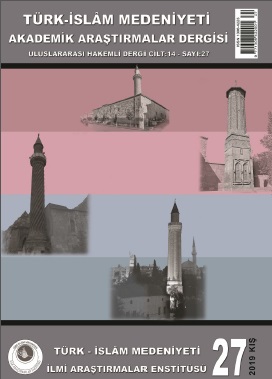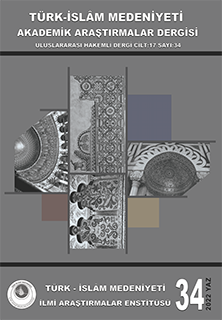New Interpretation Of Alan-Gho’a In Akbar-Name
Keywords:
Alan-gho’a, Akbar Shah, Baburid (Mughal) Empire, Timurids, Mongols, Charismatic leadershipAbstract
Alan-gho’a was the legendary ancestress of the Chinggis Khan’s Golden Lineage (Altan Urug) that retained the privilege of ruling in Central Asia through centuries. Akbar Shah, third ruler of Baburid (Mughal) Empire in India, claimed Alan-gho’a being as his ancestress. This did not depend upon his blood kinship with the Chinggisids; instead, it was claimed that the main reason for the existence of Alan-gho’a was Akbar’s divine entrance into the world; the reigns of Chinggisids and others were transitory until Akbar was born. Akbar Shah constructed his “splendid charisma” on this claim through a re-interpretation of the narrative of Alan-gho’a in a sufi mystical way making his subject people who possessed divergent religious and cultural values believe in his power and authority and uniting them around his dynasty. In this way, Akbar Shah also placed his Timurid ancestors and his lineage in a position that was superior to the Chinggisids and all the other dynasties in the World. Alan-gho’a’s new interpretation was made according to the new cultural values and social structure of his Empire which consisted of almost the whole Indian subcontinent. In this article, how and why the narrative of Alan-gho’a was re-shaped in the Akbar’s court is examined through a comparison with the Chinggisid and Timurid traditions.
References
ABU’L FAZL ALLAMI, 2000 (1907), The Akbar Nama of Abu-l-Fazl, translated: H. Beveridge, Low Price Publications, New Delhi.
ALAM, M., 2004, The Language of Political Islam; India 1200-1800, Hurst&Company, London.
ANOOSHAHR, A., 2012, “Dialogism and Territoriality in a Mughal History of the Islamic Millennium,” Journal of Social and Economic History of Orient, volume:55, Number:2/3, p.220-254.
BALABANLILAR, L., 2016, Memory and Dynastic Politics in Early Modern South and Central Asia; Imperial Identity in the Mughal Empire, I. B. Tauris.
BEVERIDGE, H., 1912 (1986), A Comprehensive History of India, volume:I With an
introduction of J.P. Gulo, Associated Publishing House New Delhi-110005.
DALKESEN, N., 2012, ”The Cult of Alan-gho’a and Unique Position of Women in the Chinggisid Dynasties”, Proceedings of Hsiung-nu Empire and the Study of Ancient Mongolian History Conference, Mongolian Academy of Science, Ulanbaatar, p.388-398.
FLEISCHER, C., 1986, Bureaucrat and Intellectual in the Ottoman Empire; The Historian Mustafa Âli (1541-1600), Princeton University Press.
FOLTZ, R., 1997, “Central Asians in the Administration of Mughal India,” Journal of Asian History, Volume:31, number: 2, p.139-154.
, 1998, “Cultural Contacts between Central Asia and Mughal India”, Central Asiatic Journal, volume:42, number:1, p. 44-65.
HUSAIN, A., 1971, “Marriages among Mughal Nobles as an Index of Status and Aristocratic Integration”, Proceedings of the Indian History Congress, volume:33,p.304-312.
JORDENS, J. T. F., 1999, (Third. Ed.), “Medieval Hindu Devotionalism”, A Cultural History of India, edited: A. L. Basham, Oxford Univ. Press, p. 266-280.
DICKSON, M., 1958, Shah Tahmasb and the Ozbeks, Published Phd. Dissertation Thesis, Princeton University.
KHAN, I.A., 2001, “State in the Mughal India: Re-examination of the Myths of a Countervision”, Social Scientist, volume:. 30, number:1-2, January-February, p.16-37.
HODGSON, M., 1974, Venture of Islam, Conscience and History in a World Civilization; The Gunpowder Empires and Modern Times, volume: 3, University of Chicago press, Chicago & London.
KAFALI, M., “Timur,” in İA (MEB), volume: 12/1, s.336.
KHANDMIR, 1342/1963-64, Giyas el-Din, Ḥabib al-Siyar fi Akhbar-i Afrad-i Bashar, Vol.3, edited: Jalāl al-Din Huma’i and Muhammad Dabir-Siyaqi, Intisharat-I Khayyam, Tehran.
KOLF, D. H. A., 1998, “A Warlord’s Fresh Attempt at Empire,” in the Mughal State 1526-1750, edited: Muzaffar Alam and Sanjay Subrahmanyam, Oxford Univ. Press.
LAL, R., 2001, “Settled, Sacred and All-Powerful; Making of new Geneologies and Traditions of Empire under Akbar”, Economic and Political Weekly, volume:36, number:11, March 17-23, p.941-958.
MANZ, B. F., 1996, The Rise and Rule of Tamerlane, Cambridge Univiversity Press, Cambridge.
O’HANLON, R., 2007, “Kingdom, Household and Body History, Gender and Imperial Service under Akbar”, Modern Asian Studies, volume: 41, number: 5, p. 889-923.
RACHEWILTZ, I., 2015, The Secret History of the Mongols: A Mongolian Epic Chronicle of the Thirteenth Century, (shorter version), Edited: Western Washington University.
RASHID AL-DIN, Fazlullah, 1387, Cami al-Tavarikh, der Tarikh-i Moghul, Edited: Behmen Kerimi, Ekbal, Tehran.
RICHARDS, J. F., 2000, The formulation of Imperial Authority under Akbar and Jahangir, “The Mughal State 1526-1750”, edited: Muzaffar Alam and Sanjay Subrahmanyam, Oxford University Press, p.126-167.
RIZVI, S.A.A., 1999, The Muslim Ruling Dynasties, “A Cultural History of India”, Edited: A. L. Basham, Oxford University Press, p. 239-265.
ROGERS, J. M., 1995, Mughal Miniatures, British Museum Press, London.
STREUSAND, D.E., 2011, Islamic Gunpowder Empires, Ottomans, Safavid and Mughals, Westview Press.
SUBTELNY, M. E., 2007, Timurids in Transition; turko-Persian Politics and Acculturation in Medieval Iran, Brill.
TAPAR, R., 1990, A History of India, volume:I, Penguin Books, London.
SKRYNNIKOVA, T. D., 2010, Rivalary between mongols and Tayići’ut for Authority: Kiyat-Borjigin Genealogy, “Representing power in ancient Inner Asia: Legitimacy, Transmission and The Sacred”, Edited: Isabelle Charleux, Gregory Delaplace, Roberte Hamayon and Scott Pearce. Center for East Asian Studies, Western Washington University, p.6-18.
TOGAN, Z. V., 1970, Umumi Türk Tarihine Giriş, Enderun Yayınları, İstanbul.
WEBER, M., 1978, Economy and Society - An Outline of Interpretive Sociology, University of California Press, New York, Berkeley, Los Angeles.
WOODS, John,1990, Timur’s Geneology, “Intellectual Studies on Islam. Essays Written in Honor of Martin B. Dickson”, University of Utah Press, Salt Lake City, p.88-125.
ZIEGLER, N., 1978, Some Notes on Rājpūt Loyalties during the Mughal Period, “Kingship and authority in South Asia”, Edited: J. F. Richards, Univ. of Wisconsin South Asian Studies, Madison, p.215-251.
Downloads
Published
How to Cite
Issue
Section
License

This work is licensed under a Creative Commons Attribution-NonCommercial 4.0 International License.







